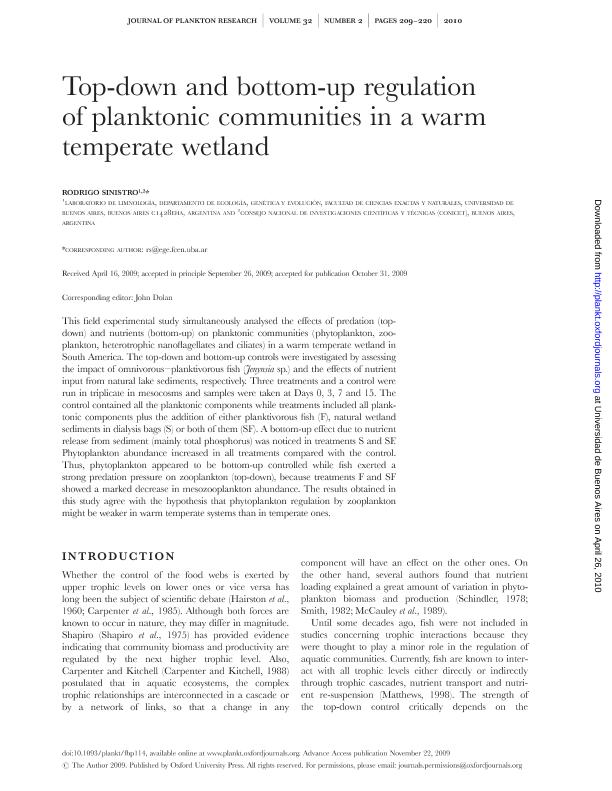Artículo
Top-down and bottom-up regulation of planktonic communities in a warm temperate wetland
Fecha de publicación:
02/2010
Editorial:
Oxford University Press
Revista:
Journal of Plankton Research
ISSN:
0142-7873
Idioma:
Inglés
Tipo de recurso:
Artículo publicado
Clasificación temática:
Resumen
This field experimental study simultaneously analysed the effects of predation (top-down) and nutrients (bottom-up) on planktonic communities (phytoplankton, zooplankton, heterotrophic nanoflagellates and ciliates) in a warm temperate wetland in South America. The top-down and bottom-up controls were investigated by assessing the impact of omnivorous-planktivorous fish (Jenynsia sp.) and the effects of nutrient input from natural lake sediments, respectively. Three treatments and a control were run in triplicate in mesocosms and samples were taken at Days 0, 3, 7 and 15. The control contained all the planktonic components while treatments included all planktonic components plus the addition of either planktivorous fish (F), natural wetland sediments in dialysis bags (S) or both of them (SF). A bottom-up effect due to nutrient release from sediment (mainly total phosphorus) was noticed in treatments S and SF. Phytoplankton abundance increased in all treatments compared with the control. Thus, phytoplankton appeared to be bottom-up controlled while fish exerted a strong predation pressure on zooplankton (top-down), because treatments F and SF showed a marked decrease in mesozooplankton abundance. The results obtained in this study agree with the hypothesis that phytoplankton regulation by zooplankton might be weaker in warm temperate systems than in temperate ones.
Palabras clave:
Top-Down
,
Bottom-Up
,
Phytoplankton
,
Wetland
,
Trophic Cascade
Archivos asociados
Licencia
Identificadores
Colecciones
Articulos(IEGEBA)
Articulos de INSTITUTO DE ECOLOGIA, GENETICA Y EVOLUCION DE BS. AS
Articulos de INSTITUTO DE ECOLOGIA, GENETICA Y EVOLUCION DE BS. AS
Citación
Sinistro, Rodrigo; Top-down and bottom-up regulation of planktonic communities in a warm temperate wetland; Oxford University Press; Journal of Plankton Research; 32; 2; 2-2010; 209-220
Compartir
Altmétricas




